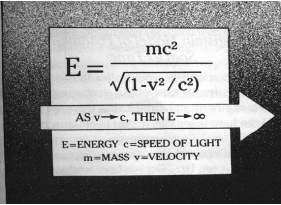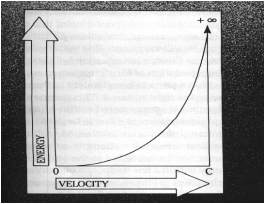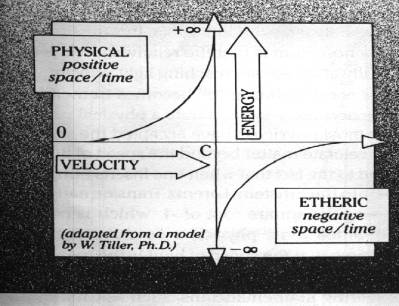|
The series of mathematical formula which Albert Einstein gave to the world in 1905, he called "A Theory of Special Relativity". Einstein brought to our attention that the factors of Gravity, Space, Time and Energy were not absolute and independent entities, but that they were variable factors, each having a value which depended upon the value of others.
In almost every text book on physics in the world today the statement is made that the quantity C represents the velocity of light (in centimeters per second), yet every student in the world who has studied the subject, knows that the velocity of light is not a constant. That its velocity, in fact, varies slightly with each different medium through which it is propagated. Any student who has ever passed a beam of sunlight through a prism to produce a spectrum of color, has demonstrated that not only does the velocity of light vary in different media, but that the change in velocity varies somewhat with the frequency of the light when propagated in material media. This of course is the principal upon which all of our spectroscopes are designed, although most textbooks state merely that the light is refracted or `bent' in passing from one medium to another. There are many who will dispute the statement that the change in velocity varies with the frequency, but when sufficiently precise tests are made entirely within a single medium, the results indicate convincingly that this is true.
Spectrum made visible by Dispersion with a Prism

At this point most students will remark that the quantity C refers to the velocity of light in a perfect vacuum, but where in the universe can we find a perfect vacuum in which to test this assertion? Astronomers and physicists have estimated that even in the remotest depths of intergalactic space there will probably be found, from three to seven nuclear or atomic particles per cubic centimeter. A beam of light traveling at approximately 3x1010 centimeters per second would still encounter a rather large number of such particles during each second of its journey. While it is true that the proportionate decrease in velocity which would be produced by this minute concentration of matter is so small that it might be negligible for all practical purposes of measurement, nevertheless it demonstrates the fact that we have chosen as our sole remaining constant, a quantity which actually can never be a perfect constant anywhere in the know universe.
Fortunately there is a value to which the quantity C can be assigned which is a constant. Moreover the assignment of the quantity C to this factor makes possible a much better understanding of the natural laws involved in the propagation of energy. The quantity C is actually the kinetic energy equivalent of the mass energy of matter. In other words, if we take a gram (or any other quantity of matter: Newtonian mass) and convert that matter gradually into energy according to the formula E=mc2, and the resultant energy, as it appeared, were constantly applied to the remaining matter in such a way as to accelerate it uniformly in a given direction, when all the matter had been so converted we would find that we had zero Newtonian mass, infinite inertial mass and a resultant velocity equal to the quantity C, or approximately 3x1010 centimeters per second (with respect to the given reference or starting point). The maximum velocity attained would always be the same regardless of the quantity of matter with which we started. This is a fact which can easily be verified by anyone who is mathematically inclined, and who is familiar with the laws of acceleration. The energy required to accelerate each gram of mass to the velocity C through energy conversion is exactly equal to total energy inherent in any matter having that mass.
This fact forms the true basis of the statement in our present day physics that the velocity C is a maximum or limiting velocity, since it represents the greatest kinetic energy differential which can exist between two given reference points. Another assumption in the theories of relativity given to the world by Dr. Einstein, the natural laws, in general, are assumed to be linear, but the space in which they operate is considered to be "curved". This concept offers the simplest mathematical presentation, since all of the deviations from linearity can thus be explained by a single postulate. Unfortunately, like most of our mathematical presentations, the concept offers but little for the mind to grasp. A curved space cannot be pictured mentally, nor can it be drawn upon paper. The question always arises, if space is inside the curve, what is outside?
We have discovered that the linear mathematics which we commonly apply to the rules of nature, do not hold true when carried to an extent which permits the error to be measured, because they do not follow a straight line reaching to infinity, but a curve of finite radii. In a timeless universe, this curve, in any given plane, would be represented by a circle, but since the laws operate through time as well as space, the curve may be more readily understood if depicted as a "sine curve" or "wave". The "base" line of the wave (which is the center line of the curve) represents zero, and the portions above and below the line represent the positive and negative aspects of the law. Thus we see that there are points and conditions in which the natural laws reach zero value with respect to a given reference point, and that beyond these points the laws become negative, reversing their effect with respect to the observer.
The constant repetition of the term "reference point" or "observer" is necessary to emphasize the frequently unrecognized fact that none of the basic factors of nature have any reality or significance except when considered from a specified position or condition. If, therefore, we exchange the existing mathematical postulate of linear laws operating in a curved space, for a concept based upon the curvature of natural law, we will find that we have not invalidated or changed any of the presently accepted mathematics which we apply to these concepts. They can still be applied in the same way, and will give the same results.
By the exchange, however, we will have achieved a position from which the operation of the natural laws can be pictured by the mind, and can be charted upon paper. It will be helpful for the reader to examine at this time, a more advanced, yet contemporary model in the existing framework of science, for comparison purposes. The easiest way to the unknown is through the known.
Although most contemporary scientists would offer the assumption that no mathematical models currently exist within electromagnetic theory to explain the existence of scalar vectors as a fundamental originating force in vacuum (or ether), there are an increasing number of prominent researchers revisiting this area. Those In the forefront, notably, Thomas Bearden, Moray King, Henry Monteith, Paul LaViolette and Shinichi Seike, are taking a closer scrutiny of the pioneering work of E.T. Whittaker, Nikola Tesla, T.T. Brown and Burkhard Heim. The list certainly is not exhaustive. One such researcher is Dr. William Tiller, a professor at Stanford University and former chairman of the department of Materials Science. It is his model we are looking at.
Dr William Tiller has spent over a decade on a theory that others are now calling the Tiller-Einstein Model of Positive - Negative Space/time. Richard Gerber calls it the Tiller-Einstein Model because it's insights are basic to the Einsteinian equation relating energy to matter from which it is derived. The most familiar form of this equation is as follows:
E=mc2, however this is not the entire expression. The shorter equation is modified by a proportionality constant known as the Einstein-Lorentz Transformation. This transformational constant is the relativistic factor that describes how different parameters of measurement from time distortion to alteration of length, width,and mass will vary according to the velocity of the systems being described the true Einsteinian equation is as below:
Diagram 1 Einstein-Lorentz Transformation

The classical interpretation of Einstein's famous equation is that the energy contained within a particle is equivalent to the product of its mass multiplied by the speed of light squared. This means there is an incredible amount of potential energy stored within a tiny particle of matter. A more complete understanding of Einstein's equation has evolved over time which may begin to help scientists comprehend the multi-dimensional nature of the universe. Einstein's equation suggests that matter and energy are interconvertable and interconnected. Subatomic matter is actually a form of condensed particularized energy i.e. a frozen mini-energy field. The atomic bomb is one example how matter can be converted into energy. When one examines the extended equation above in which E=mc2 is modified by the Einstein-Lorentz Transformation new insights into the dimensional aspects of matter both gross and subtle matter can be appreciated. If one accelerates a particle faster and faster until it approaches the speed of light its kinetic energy increases exponentially as described by the equation K.E.=½mv2, where v is velocity. see diagram below.
Diagram 2 Relationship of Energy to Velocity

An interpretation of this relationship could make it seem that it is physically impossible to accelerate particles beyond the speed of light. The ascending curve approaches the speed of light (c) but never intersects with it and continues off into infinity. High energy physicists are aware that as one tries to accelerate a subatomic particle faster and faster close to the speed of light, extremely large amounts of energy are needed. The reason is because the relativistic mass of a particle increases exponentially at speeds approaching light velocity, until the energy needed for further acceleration to 'c' becomes tremendous. This tremendous energy is what is necessary to accelerate a physical particle of matter. Physicists have accepted the seeming limitation that one cannot accelerate matter beyond the speed of light. This assumption is partly related to the fact that when one inserts numbers greater than the speed of light into the Einstein-Lorentz Transformation one arrives at the solutions containing the square root of -1, which is considered an imaginary number. Here we face a wall of unbelief by physicists who do not believe in imaginary numbers, they assume that the speed of light is the maximum velocity at which matter can travel. However there are a few renegades who believe differently.
Pioneering mathematician Charles Muse1 considers the square root of -1 to be a category of numbers referred to as "hypernumbers." These hypernumbers are necessary to the development of equations which described the behaviour of higher dimensional phenomena (such as the subtle energy interactions of living systems). Muse points out that even though imaginary numbers like the square root of -1 may seem impossible to fathom, they are necessary to find solutions in the equations of electromagnetic and quantum theory.
We make the assumption that solutions containing the square root of -1 may be valid in describing higher dimensional phenomena. This allows us to begin to understand the full predictive power inherent in the transformed Einsteinian equation. The diagram below is a plot of the energy of a paricle relative to it's velocity from a particle relative to its velocity from a theretical state of rest all the way to beyond the speed of light (c).
Diagram 3 Positive-Negative space/Time Model

|